Abstract
Quality management during construction is critical to ensuring compliance with technical specifications and quality standards. Traditional practices often rely on manual, paper-based documentation, leading to inefficiencies, data fragmentation, and poor traceability. This study presents QualiSite, a novel digital workflow that integrates Building Information Modeling (BIM) and Geographic Information Systems (GIS), aligned with ISO 9001:2015 requirements, to enhance quality management in building projects. The research is framed under the Design Science Research Method (DSRM), guiding the iterative development and validation of the tool. QualiSite was tested in a real-world case study involving the construction of reinforced concrete walls. The results demonstrated functional improvements in inspection traceability, consistency of quality records, and coordination between field data and BIM elements. Using structured digital forms contributed to more consistent data capture and greater efficiency in recording, organizing, and visualizing quality control statuses within the 3D environment. These outcomes enabled transparent inspection processes and clear visualization of quality status across construction elements. The digital workflow also facilitated the identification of nonconformities and streamlined communication between field inspectors and model managers. This approach advances traditional quality management by embedding inspection records into a Cyber-Physical Systems (CPS) framework, contributing to the digital transformation of the Architecture, Engineering, and Construction (AEC) industry and supporting the vision of Smart Industry.
1. Introduction
In the Architecture, Engineering, and Construction (AEC) industry, quality can be understood as the characteristics related to fulfilling requirements and customer satisfaction [1]. On the other hand, quality management is a fundamental aspect that guarantees the delivery of high-quality, safe, and functional construction projects [2]. It aims to ensure that the products or services meet or exceed the customer’s requirements and expectations, ensuring compliance with current regulations and the technical specifications of the project [3]. Building projects are characterized by many activities running in parallel, many stakeholders, and high budgets [4]. This highlights the importance of having a good Quality Management System (QMS) [5]. Conventional methods used for quality management are characterized by paper-based collection and recording of data, together with storing and managing information on platforms without access to all stakeholders [6]. This often results in redundancies, subjective control, lack of efficiency, and information fragmentation that does not allow stakeholders to have a clearly defined quality management process [7,8]. Consequently, the probability of quality errors could increase, causing enormous associated costs, amounting to up to 25% of the total project cost [9]. The industry has adopted some strategies to improve QMS, such as Total Quality Management (TQM) [10], Lean Construction [11], Six Sigma [12], Statistical Process Control (SPC) [13], and Failure Mode and Effects Analysis (FMEA) [14]. On the other hand, standards have been developed to promote the development of a QMS, including pathways for certification. The International Organization for Standardization (ISO), through the ISO 9001:2015 standard, provides a framework for organizations to implement and maintain effective quality management practices [15]. It is based on compliance with seven principles: customer focus, leadership, people involvement, process approach, continual improvement, factual approach to decision-making, and relationship management [16]. It is one of the most widespread quality standards in the construction sector [17], with an increasing number of companies seeking certification, since these standards guarantee a good QMS [18].
One of the most widely used methodologies in construction project management is Building Information Modeling (BIM) [19]. BIM is characterized by offering a collaborative approach that consists of the use of a multidimensional parametric model throughout the entire project life cycle [20]. Its use improves how project quality information is managed, as it has the potential to enhance stakeholder collaboration [21]. Despite its potential, BIM has seen limited application in project quality management, showing uses at the design stage to avoid quality defects in later phases [22]. On the other hand, the implementation of Geographic Information Systems (GIS) tools allows the management of geospatial information of the elements that make up the structure, as well as the resources involved in its execution [23]. Specifically, during the construction stage, this geo-referencing capability has been used to identify hazardous areas, plan safe routes, as well as optimize the logistics of delivery of materials and equipment, providing quality management data such as reports, photographic records and drawings, and all quality-related activities and decisions that can be managed in an accurate way [24]. The use of GIS in conjunction with BIM can be quite helpful for recording data related to quality during construction [25,26]. Although BIM and GIS have individually demonstrated potential in enhancing various aspects of construction management [27], their combined application for quality management has been mostly limited to infrastructure and prefabrication contexts. For example, Han et al. [28] developed a BIM-GIS framework for pavement construction quality evaluation, while Li et al. [4] used both tools to study carbon emissions in prefabricated concrete panels. However, none of these studies address vertical building construction projects, where quality management involves different spatial challenges and coordination requirements. In addition, existing studies [29] do not specifically align their approaches with ISO 9001:2015. Therefore, this research aims to develop and validate a method that integrates BIM and GIS to support ISO 9001:2015-based quality management workflows in building construction projects.
Furthermore, the proposed approach can be framed within Cyber-Physical Systems (CPS), where integrating digital technologies and physical construction processes facilitates automated data collection, real-time monitoring, and structured decision support [30]. These capabilities align with the current trends in the smart industry, which emphasize the use of interoperable digital tools to enhance efficiency, traceability, and responsiveness in construction quality management.
This research aims to develop and validate a method that integrates BIM and GIS to support ISO 9001:2015-based quality management workflows in building construction projects. This integration is intended to enhance traceability, georeferenced inspection control, and digital transformation in quality processes throughout the construction phase. This research is guided by the following question: To what extent can the integration of BIM and GIS, aligned with ISO 9001:2015, improve the traceability and effectiveness of quality management processes in building construction projects?
In line with this objective, this study contributes a novel digital workflow that integrates BIM and GIS technologies explicitly aligned with ISO 9001:2015 requirements for construction quality management. This integration enables georeferenced, process-based inspection records within the BIM environment, enhancing traceability, documentation, and compliance with international quality standards.
In addition to the theoretical framework, this study responds to practical challenges commonly faced in construction quality management environments, including fragmented information across stakeholders, paper-based documentation processes, and difficulties in accessing or updating inspection data in real time on-site. These challenges hinder traceability, slow down decision-making, and increase the risk of errors during construction. The proposed tool, named QualiSite, was explicitly designed to address these challenges by enabling centralized, georeferenced, and digitally accessible quality records within the BIM environment. To demonstrate its applicability, a case study was conducted focusing on the construction of reinforced concrete walls. This implementation allowed linking the status and progress of quality controls with a parametric BIM model, facilitating visualization and management of inspection documentation during construction. QualiSite improved the traceability of quality data and supported informed decision-making, helping to prevent errors during the construction phase [31].
The article is organized as follows: Section 2 presents the stages of the research methodology. Section 3 presents the state of the art of quality management, BIM, and GIS. Section 4 presents the workflow followed for the development of the tool. Section 5 presents the details of the case study and the results obtained. Section 6 presents the discussion. Section 7 presents the conclusions.
2. Research Methodology
This research proposes QualiSite, a tool based on integrating BIM and GIS and aligned with ISO 9001:2015 requirements, to improve traceability and storage of quality management data during the construction phase. The work follows the Design Science Research Method (DSRM), designed to address an identified problem through an artifact proposal and its validation. This adaptation of the DSRM is structured into four stages, as presented in Figure 1: (1) problem identification; (2) definition of objectives for a potential solution; (3) design and development; and (4) demonstration [32].
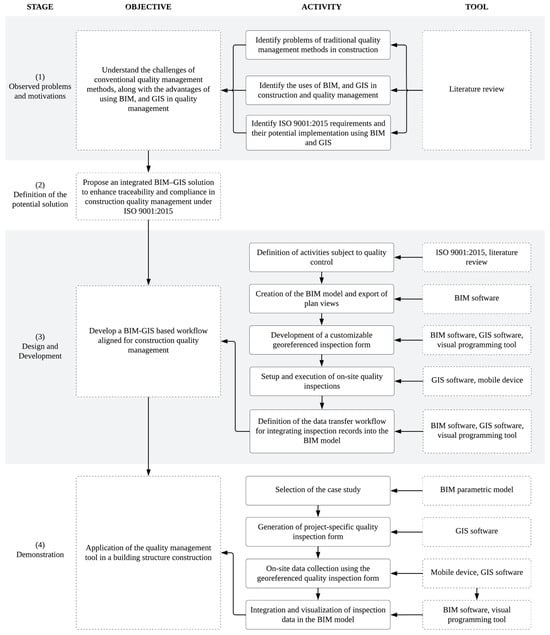
Figure 1.
Research methodology based on DSRM, adapted from [32].
In the first stage, a literature review was conducted using Scopus and Web of Science, alongside an analysis of ISO 9001:2015 and other relevant quality management standards. This process allowed the identification of key limitations in current construction quality management practices, including manual documentation, limited traceability, and insufficient integration of digital tools. In parallel, the review examined the existing applications of BIM and GIS in the construction sector, assessing their potential to address these challenges. The results of this stage provided the basis for identifying relevant ISO 9001:2015 requirements that could be supported by integrating BIM and GIS technologies.
In the second stage, a conceptual framework was formulated to integrate BIM and GIS into a unified system for quality management in construction projects. This approach emphasizes the connection between quality inspection data and a georeferenced digital model, aiming to improve traceability, data centralization, and alignment with ISO 9001:2015 principles.
The third stage focused on translating the conceptual model into an operational workflow. This included selecting applicable ISO 9001:2015 requirements for on-site quality control, developing a customizable georeferenced inspection form adaptable to different projects, and setting up the mobile tools and procedures required to perform on-site quality inspections. Additionally, the data transfer workflow was defined to enable the integration of inspection results into the BIM model. The implementation of this workflow used GIS platforms, mobile devices, and visual programming tools to automate the insertion and visualization of quality data within the digital model.
In the fourth stage, the proposed workflow was applied in a case study involving the construction of reinforced concrete walls. A project-specific inspection form was created and deployed in the field using a mobile device and GIS software for real-time data collection. The collected information was then transferred to the BIM model, enabling visualization and review of the inspection data directly within the digital environment. This stage served to assess the functionality of QualiSite and applicability to real-world construction quality management.
3. Literature Review
This section is structured as follows: First, an overview of the current state of quality control in the construction industry, focusing on construction projects, is given. Second, the current methods of quality control in construction projects are considered. Finally, the application status of BIM and GIS in construction projects and their potential in quality management during the construction phase are presented.
3.1. Quality Management in Construction Projects
The construction stage is characterized as one of the most resource-intensive stages of a project, accounting for 70–80% of the total project cost. This is because it encompasses a significant portion of the project life cycle before its operation [33]. At this stage, multiple stakeholders are involved, making it crucial to ensure both the proper execution of planned tasks and the quality of their outcomes [34]. The quality control strategies employed at this stage consist of performing on-site evaluations of the different elements and comparing the results with the established requirements [33,35]. Likewise, defect management is indispensable for quality control, since it consists of identifying, record, reporting, and fixing the failures observed in site quality inspections during the construction process [36]. Studies from the United States, United Kingdom, and Latin America have revealed that deficiencies in quality management can represent approximately 5% to 25% of the total cost of the project [9]. Given this context, the creation of an efficient and effective QMS can have a positive impact on the project [37]. Several tools exist in the industry that can be applied for QMS. Some standards have focused on quality requirements that concentrate on specific areas. Among them, the PMBOK® is one of the widely known standards, which provides management practices for the entire project life cycle, including the execution stage and quality-related aspects [38]. ASTM specifies quality requirements for testing and inspection of materials [39]. On the other hand, the AISC Quality Management System Certification presents specific requirements for steel construction [40]. Other organizations present general standards, which can be applied to different types of organizations to certify their processes. Among them is ISO, which developed the ISO 9001:2015 standard, focused precisely on the quality management of organizations [15]. This standard has been widely applied in the construction sector, providing certification of organizational QMS [41]. This certification provides several benefits for organizations, including a higher level of customer reliability, standardization of their processes, and reduced costs for errors and rework [42].
3.2. Current Quality Control Methods
In building projects, current techniques for quality management consist of filling in physical records such as checklists, inspection forms, and digital reports, such as photos, videos, or spreadsheets [43,44]. The standard way to manage quality in this type of project starts with defining the quality requirements for each planned activity and the phases that compose them. Then, the inspections are executed using records, which must be signed by supervisors of the executing party, and quality inspectors [45]. These documents are used as quality certification and are often stored on paper or digital platforms that are not universally accessible [46]. This results in problems associated with interpretation, traceability, and loss of information. These problems become even more critical in the presence of nonconformities and errors in the quality of the results, where it is necessary to communicate the failures and provide quick solutions to meet the quality requirements [47]. Given the nature of traditional methods, these situations frequently lead to issues in collaboration, coordination, and limited feedback [48]. A survey conducted in Taiwan reaffirms this situation, revealing that some of the main problems in defect management include the following: the inability to manage quality defects effectively during the construction phase, the lack of complete records for each defect, and the lack of effective platforms to improve quality inspection and work with such documentation [49]. Based on the above, new technologies based on the digitization of processes can be a great alternative to address the existing gaps in current methods. In this way, it is possible to develop innovative approaches and improve the efficiency of the quality management system [33,50].
3.3. BIM for Quality Management
In the last decade, BIM has become a crucial tool for promoting collaboration and digitization in construction projects [51]. In terms of quality, BIM offers alternatives for managing information in a centralized way on a virtual replica, ensuring data traceability [52]. Conflict detection techniques allow identifying, sharing, and communicating defect information between disciplines in a collaborative virtual model [49], avoiding quality defects, and eliminating major system conflicts before installation [53]. While control and planning using BIM models can provide essential information on construction elements, quality standards, control procedures, and assignment of responsible parties, facilitating compliance with quality requirements [54,55]. Additionally, the integration of BIM models with portable devices, such as tablets or mobile phones, through cloud-based linking of information, has led to enhanced stakeholder involvement [56], including the elimination of paper-based tasks, improved reporting systems, rework avoidance, and prompt information updating throughout the project life cycle [57]. Several studies in the literature have proposed management and quality control models based on BIM [58]. Table 1 shows a comparison between the mentioned applications, considering the following parameters:

Table 1.
Comparative table of literature BIM applications for quality management.
- Reference of the article;
- Aim of the article;
- Tools employed for quality data collection from construction sites;
- Type of structure used for the case study;
- BIM software used within the workflow of the proposed method;
- Hardware employed in the quality management tasks;
- Maturity level of the proposed method in the research concerning its application item.
The studies included in Table 1 were selected based on their relevance to construction quality management during the execution phase and their incorporation of BIM technologies to support data collection, traceability, or quality documentation. The selection aimed to represent a range of technological approaches, application contexts, and maturity levels described in the literature. In some cases, specific information about the data acquisition methods was not provided in the original articles; these instances are indicated as “N.S.” (Not Specified) in the table.
The characterized studies show advances focused on the development of automation in acquiring, storing, and managing quality control information on-site. Revit is presented as the leading BIM software, serving as the central tool for modeling and information management [65]. However, most of them stand out for integrating software tools, including programming environments, and virtual data storage servers [66]. Regarding hardware, mobile devices are used to fill out forms and checklists in the field and to capture images to record evidence in quality controls. Integrating all these tools has proven to generate value in data processing quickly and effectively.
Moreover, the incorporation of semi-automated data workflows within BIM models supports real-time monitoring and structured decision-making in quality control processes [67]. Integrating inspection data directly into the model environment enables more efficient tracking of construction quality and timely identification of nonconformities. These functionalities align with the evolution of autonomous systems in Smart Industry, where the goal is to enhance construction oversight through interoperable digital platforms and CPS integration [68].
Although several studies have proposed BIM-based workflows for construction quality management, most focus on internal model coordination, document centralization, or defect detection during the design or pre-construction phase. Few incorporate mechanisms for integrating field inspection data during the execution stage, and none explicitly align their models with ISO 9001:2015 quality requirements. In contrast, the approach proposed in this study enhances traceability by linking inspection data to BIM elements during construction. It supports quality compliance through structured, ISO-based documentation embedded in the model. While these BIM-based approaches demonstrate advancements in data centralization, defect tracking, and on-site reporting, they typically focus on coordination or visualization tasks. Most lack integration mechanisms for aligning field inspection data with quality control processes explicitly structured according to ISO 9001:2015 requirements. Specifically, they do not support traceable, phase-based inspection workflows or define compliance status through standardized quality indicators, critical for process certification and auditability.
3.4. GIS for Quality Management
GIS technologies have been widely employed in construction quality management, particularly in monitoring materials and processes, surveying ground conditions, and generating field reports. Chen et al. [24] highlighted the potential of GIS to streamline material supply chains by reducing errors, time, and costs. Similarly, Bansal [69] explored GIS applications during pre-construction, including regulatory compliance, terrain modeling, and 4D visualization for planning and resource management. Several studies have proposed GIS-based quality management frameworks centered on construction monitoring. For example, Dib et al. [70] and Chowdary et al. [71] developed systems that used CAD files, QGIS, and project documentation to generate georeferenced 4D models for real-time monitoring, reporting, and quality evaluation. These approaches emphasized integration with scheduling tools and database-driven performance analysis. In parallel, other research efforts have focused on integrating GIS with BIM for quality management in infrastructure and prefabrication projects. Han et al. [28] presented a framework combining Revit, Navisworks, Infraworks, and ArcGIS for real-time quality evaluation in pavement construction, while Li et al. [4] examined the spatial distribution of the carbon footprint in prefabricated concrete panel activities using GIS and CAD-integrated BIM models. These studies reveal that GIS tools for quality management often rely on combined CAD, spreadsheets, and BIM-linked formats. This interoperability is crucial when selecting GIS software for construction quality tasks. The GIS software tools compared in Table 2 were identified by reviewing studies focusing on their use in quality control, data collection, and integration with other digital platforms in construction projects. The characterization focused on functional capabilities relevant to fieldwork, system compatibility, and cloud integration for on-site quality management. Integrating automated monitoring functionalities within GIS applications, such as digital tracking of construction materials and processes, establishes a foundation for more efficient and responsive workflows. These capabilities contribute to the development of CPS in the construction industry, supporting real-time supervision, enhancing traceability, and reducing reliance on manual oversight. This aligns with Smart Industry objectives, where interoperable systems foster improved quality control and informed decision-making [72].

Table 2.
Comparison of GIS software tools used in the literature for quality management in construction projects.
As shown in Table 2, the GIS tools most frequently used in the literature vary widely regarding licensing model, platform compatibility, and support for mobile applications and cloud-based data storage. While proprietary solutions such as ArcGIS offer advanced integration capabilities, open-source alternatives like QGIS stand out for their flexibility, extensibility, and compatibility with mobile tools such as QField. These characteristics are particularly relevant in construction scenarios that require georeferenced field data collection and seamless integration with BIM environments. The comparative analysis in Table 2 guided the selection of GIS tools in the proposed methodology, prioritizing those that enable real-time inspection workflows and digital quality documentation.
Despite the growing use of GIS in construction quality management, most implementations are limited to supporting isolated tasks such as reporting or monitoring, without full integration into centralized quality systems or connection with BIM models. Furthermore, aligning GIS-based quality processes with international standards such as ISO 9001:2015 remains largely unexplored. A similar limitation is observed in several BIM-based studies reviewed in Section 3.3, many of which focus on model coordination or defect tracking, but do not implement structured, standard-compliant inspection workflows. Given this overlap in scope and the recurring omission of ISO-aligned processes, this study seeks to advance the state of the art by integrating georeferenced inspection data into BIM-based representations, within a traceable and certifiable quality management framework aligned with ISO 9001:2015.
4. Method
The development of QualiSite focuses on supporting the fulfillment of requirements present in ISO 9001:2015 for the definition of a QMS [15]. Three fundamental aspects were defined to support the development of the quality management tool. These include the following: (1) a defined workflow for quality inspection, (2) the digitization of inspection data collected in the field, and (3) the use of GIS and BIM models in the storage, management, and visualization of quality information.
Defining a workflow enables inspections to be conducted using a clear and structured method. This will allow for the identification of the type of documentation and data involved in the process, increasing efficiency and minimizing errors. Additionally, digitizing inspection data enhances accessibility to field-related quality information. The digital format facilitates rapid, continuous, and multi-device access via the Internet, allowing quality professionals to store, share, and analyze data more effectively. As a result, it becomes easier to detect patterns and trends that support informed decision-making.
Finally, combining GIS with BIM models offers significant potential for spatial and multidimensional monitoring of built environment elements. The use of software tools that enable user-friendly data visualization supports collaborative decision-making in the context of quality management. Figure 2 illustrates the key aspects considered in the development of the proposed quality management tool.
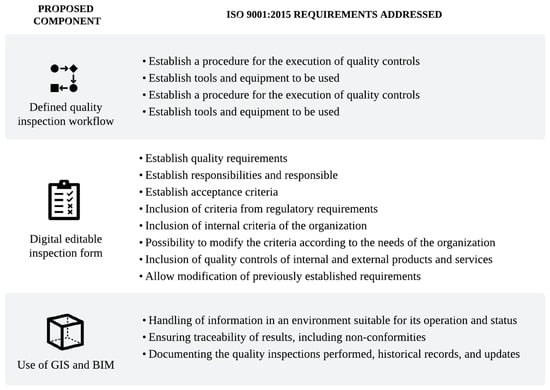
Figure 2.
ISO 9001:2015 requirements addressed by the proposed quality management tool.
The three components of the proposed tool were defined to align directly with core principles of ISO 9001:2015. The structured inspection workflow supports process-based quality management through consistency, planning, and responsibility assignment. Using digital, editable inspection forms enables control of records, historical traceability, and the definition of acceptance criteria. Meanwhile, integrating GIS and BIM technologies allows for georeferenced quality inspections, centralized documentation, and evidence-based decision-making. The tool provides a prototype that links inspection progress with the BIM model during the construction phase, enabling the visualization of control status for each building element. Each element is considered complete once all relevant inspections have been fulfilled according to its specific quality requirements. Figure 3 shows the workflow followed for the development of the tool, corresponding to Stage 3 (“Design and Development”) of the DSRM. The main characteristics of each stage are reviewed in the following Section 4.1, Section 4.2, Section 4.3 and Section 4.4.
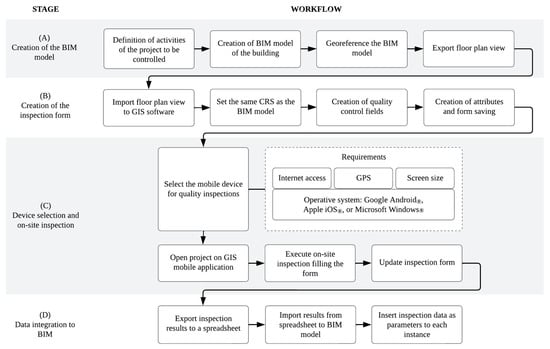
Figure 3.
Workflow for QualiSite, the proposed quality management tool.
4.1. Stage A: Creation of the BIM Model
To create the BIM model, it is necessary to know which activities of the construction process will be subject to the quality controls, as well as the parameters associated with the quality requirements defined for each control. This will allow the establishment of an appropriate level of development (LOD) when generating the elements represented in the virtual model. Revit software has been defined for modeling, given its excellent compatibility with drawing file-sharing formats and its large user community. Furthermore, Revit has complementary tools, including Dynamo, which allow the automation of data transfer between external files and the model file. Once the building model has been entirely generated, it must be georeferenced by establishing a coordinate reference system (CRS). The final step is the export of drawings in DXF format, which will then be incorporated into the GIS software. Since it has been defined to work the quality controls using geolocation data, a plan view must be extracted, in which all the elements subject to quality inspection are displayed.
4.2. Stage B: Creation of the Inspection Form
The inspection form for quality control was developed using QGIS software. Starting from the georeferenced BIM model, a plan view in DXF format was imported as a new geopackage layer and configured with the same CRS. This layer allows the creation of control points, each associated with customizable fields defined by the user, including text, dates, and numerical inputs. These fields are grouped into quality attributes, which structure the form according to the control phases of the project. The configuration also allows dropdown menus and display ordering. Figure 4 shows a reference of the field and attribute setup. Once completed, the QGIS file is synchronized with QFieldCloud using the QField Sync plugin, enabling access to the inspection form from a mobile device.
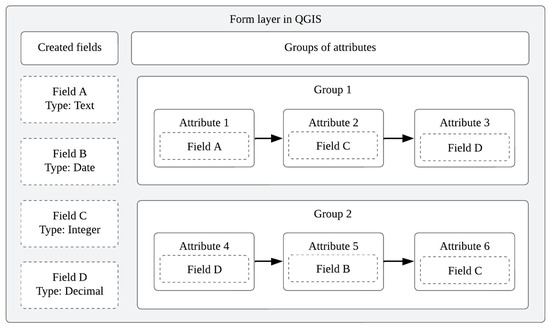
Figure 4.
Reference for the creation of fields and attributes within a QGIS geopackage layer.
4.3. Stage C: Device Selection and On-Site Inspection
The on-site inspection process is carried out using a mobile device with the QField application, which accesses the synchronized inspection form from QFieldCloud. To ensure proper operation, the selected device must meet the following minimum requirements:
- Stable internet connection for uploading data and maintaining synchronization with QFieldCloud;
- Operating system compatible with the QField application (Android®, iOS®, or Windows®)
- Built-in GPS for real-time geolocation during inspection;
- A screen large enough to display both the project floor plan and the inspection form (a tablet is recommended).
Once the inspector logs in to the QField application and synchronizes the project, the inspection begins by activating the editing mode of the inspection layer. The operator selects the elements to be inspected directly from the floor plan view and adds new control points at their physical location. The GPS continuously updates the inspector’s position, allowing accurate spatial association between the control point and the actual element. The inspector completes the form for each control point by filling out the fields grouped under the relevant quality attributes. The system also allows the inspector to return to previously created control points to make necessary corrections or updates. After completing the inspection of all required elements, the operator selects the “upload changes” option, which updates the QGIS file with the collected data. This information can then be accessed from a computer to continue the quality control process. Figure 5 summarizes the overall workflow for field inspection using QField.

Figure 5.
Quality inspection form filling process, using QField application.
4.4. Stage D: Data Integration to BIM
The final stage of the process involves integrating the inspection data collected on-site into the BIM model using Dynamo, a visual programming environment included in Revit [79,80]. This step facilitates the direct embedding of information gathered from the field into the parametric elements of the digital model. Once the inspection form has been completed and synchronized via QFieldCloud, the updated QGIS file is exported in XLSX format. This spreadsheet contains the inspection results associated with each control point. Dynamo then automates the process of incorporating these data into the BIM model through the following tasks [81]:
- Import the XLSX file containing the inspection form data into Revit;
- Create shared parameters within the categories of model elements subject to quality controls;
- Identify the corresponding model instances, based on spatial references or element identifiers;
- Filling in the parameters created with the inspection data on the corresponding model instances;
- Enabling visualization and tabulation of the inspection results within the BIM environment.
This integration begins with the operator synchronizing the project via QFieldCloud to ensure all field data are up to date. Once the inspection records are inserted into the BIM model through Dynamo, the new parameters can be used within Revit to visualize, filter, and organize the quality control data. This allows monitoring the compliance status of each element, supporting traceability and informed decisions during the construction process.
5. Results
This section details the characteristics of the case study used and the quality controls considered, followed by applying the proposed method and the results obtained.
5.1. Case Study
The selected case study corresponds to a house in Curauma, Valparaíso, Chile. Its configuration is a single level with a surface area of 96 m2, and its design is based on the construction of a reinforced concrete wall system. Figure 6a shows its location on the map, and Figure 6b, shows the floor plan drawings with the distribution of the components.

Figure 6.
Case study: (a) Satellite image of the house’s location, (b) drawings of the house.
This small-scale residential project was chosen as a controlled environment to evaluate the proposed quality management tool. Its low level of complexity made it possible to oversee the entire quality inspection process and reduce external interferences, which allowed the integration between BIM, GIS, and ISO 9001:2015-based workflows to be tested under stable conditions. This scenario was suitable for identifying technical limitations and verifying the operability of the digital workflow before extending its application to more complex or large-scale contexts.
The quality controls were applied to the construction of all reinforced concrete walls. The requirements were defined based on [82], which outlines procedures following Chilean construction standards. Three inspection phases were established: prior to concrete pouring, during pouring, and after pouring. Each phase includes specific quality verification tasks related to geometry, materials, execution methods, and performance criteria. A breakdown of these activities is presented in Table A1. Each phase must be approved before proceeding to the next, ensuring that all activities comply with the established quality requirements. In cases of non-compliance, corrective actions must be documented and subsequently revalidated. Before approval, the inspector must manually review the inspection data to confirm that all entries are complete, coherent, and consistent, thereby minimizing the risk of input errors. Figure 7 provides a diagram that summarizes the order of execution of the controls in each of the three phases contemplated.
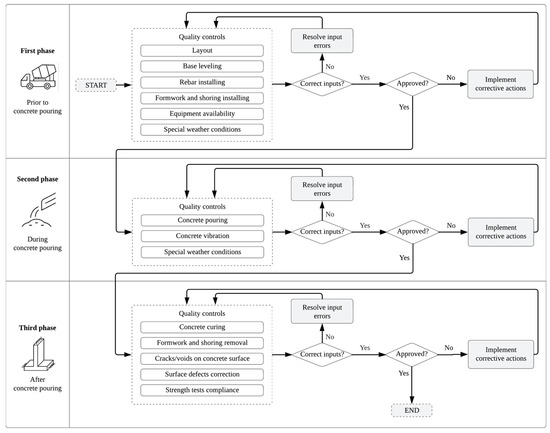
Figure 7.
Flow chart of wall construction quality control phases, based on [82].
5.2. Creation of the BIM Model and Drawing Exporting
Based on the construction drawings, a BIM model of the house was developed using Revit, with a LOD 300 for the structural discipline. The model includes the geometric and material characteristics of all walls subject to quality control. A georeferencing system was applied using the coordinates of the real construction site (CRS WGS 84/UTM zone 19S). Figure 8 presents a 3D and sectional view of the model.
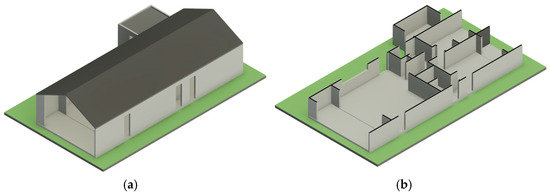
Figure 8.
BIM model generated for the case study: (a) 3D view of the entire house, (b) 3D section view.
From the georeferenced model, a two-dimensional plan view was created to visualize all the walls involved in the quality inspection process. This view was exported in DXF format using the CAD export tools in Revit, ensuring that the embedded geographic information was preserved. The resulting file was then imported into QGIS using the “AnotherDXFImporter” plugin, which converts CAD files into geopackage layers suitable for spatial analysis. The same coordinate reference system used in the BIM model was also assigned in QGIS to ensure spatial consistency. Figure A1 presents the imported floor plan, now integrated into the GIS environment for subsequent configuration of the inspection form.
5.3. Creation of the Inspection Form
A point layer, designated “Quality form”, was created in QGIS to structure the data collected during on-site quality inspections. This layer includes six fields, each corresponding to specific information required for traceability and documentation. These are:
- Quality control supervisor, which records the name of the inspector in charge of each verification;
- Status, which reflects the compliance result of the activity being inspected;
- Responsible, which identifies the person accountable for quality assurance;
- Comment, which allows inspectors to document additional notes or observations;
- Date, which captures the day the inspection was carried out;
- East coordinate and North coordinate, which record the geographic location of each inspection point using the WGS 84 coordinate system.
These fields were grouped into attributes according to the three predefined control phases. When necessary, attributes were repeated to accommodate multiple checks within a single phase. A separate group was added for the mechanical strength tests, which are performed later in the process. The resulting configuration of fields and attributes is shown in Figure A2.
The “Status” field was configured using the Value Map customization tool, allowing the inspector to select from three predefined outcomes: “Complies”, “Does not comply”, and “Corrected”. These options appear as a dropdown list during form completion, as shown in Figure A3. While QField supports using structured input types such as lists, text boxes, date pickers, and numeric fields, it does not automatically validate the overall coherence or completeness of the entered information. Therefore, it remains the inspector’s responsibility to verify that all data are accurate and fully recorded before submitting the form.
Visibility constraints were applied to enhance usability during fieldwork so that only the attributes relevant to the current phase are displayed. Once the form was configured, the QGIS project was saved locally and synchronized using the QField Sync plugin. Access rights were assigned to the form creator and the field inspector through their QFieldCloud accounts, allowing collaborative editing and synchronization Figure A4.
The structure of the inspection form incorporated several key indicators derived from ISO 9001:2015. These include the compliance status of each activity (complies, does not comply, corrected), the responsible party’s identification, the date of inspection, and the documentation of nonconformities or additional observations. Spatial traceability was ensured through georeferenced coordinates for each inspection point, which were linked to specific construction activities. These indicators support process control, documentation, and traceability requirements defined by the standard and serve as the basis for subsequent monitoring and continuous improvement.
5.4. Creation of Qfield App
For the on-site quality inspections, a mobile tablet equipped with GPS and Wi-Fi connectivity was used to run the QField application. The selected device met the necessary requirements for screen size, real-time location, and compatibility with QFieldCloud. A summary of its technical specifications is provided in Table A2.
To begin the inspection process, the field inspector accessed the application using their QFieldCloud account (Figure 9a), selected the assigned project (Figure 9b), and synchronized the latest updates (Figure 9c). Once the project was loaded, the house floor plan was displayed, and the inspector’s position was shown in real time using the device’s integrated GPS. This spatial reference facilitated navigation and inspection alignment on-site. These steps ensure proper access to the most recent inspection forms and maintain consistency between mobile data collection and the central GIS environment. Their correct execution guarantees synchronization between field observations and digital project data, which is fundamental for the traceability and operability of the proposed workflow.

Figure 9.
Key steps to initialize QField for quality inspections: (a) user authentication via QFieldCloud, (b) selection of the assigned project, and (c) synchronization of the latest project data.
The inspector initiated the on-site inspection by activating the editing mode and selecting the location of the element directly on the floor plan displayed in the application. A new control point was added, and the relevant fields of the inspection form were completed using the mobile interface. This process is illustrated in Figure 10a, which shows the creation of the inspection point on the map. Figure 10b presents the inspector performing the quality control task in front of the wall under inspection. Once the form was filled out, the inspection point was marked on the map with a green indicator, allowing the inspector to confirm its completion visually. Figure 10c shows the finalized form after completing the inspection. This stage is key in linking physical inspection activities with their corresponding georeferenced records in the digital environment. It ensures that data collected on-site are directly associated with specific building elements, supporting the traceability, consistency, and accuracy required for ISO 9001:2015-aligned quality documentation.
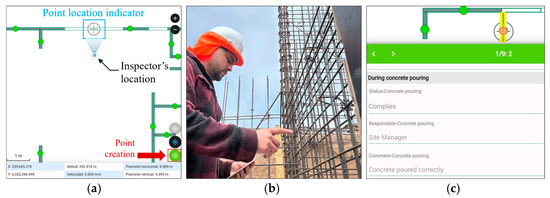
Figure 10.
Execution of georeferenced quality inspections using QField: (a) creation of an inspection point linked to a construction element, (b) visual confirmation and data entry on-site, and (c) completed inspection form.
Existing inspection points could be edited to update information or complete additional control phases. Once the inspection round was finished, the inspector uploaded the changes to the cloud using the “Upload changes” option in QFieldCloud (Figure A5), ensuring the data would be available for processing in QGIS.
5.5. Linking Quality Inspection Results to the BIM Model
After the inspection, the recorded data were synchronized from QFieldCloud and retrieved in QGIS. The synchronization procedure consisted of updating the local storage while turning off the cloud layer to ensure the correct project version was selected. Details of this process are provided in Figure A6. The updated inspection layer was then exported to an Excel spreadsheet in XLSX format, preserving the structure of the attribute data for integration into the BIM model. This export required the definition of a sheet name and file name, which remain fixed to allow consistent data linkage in future synchronizations. The configuration steps and resulting file are shown in Figure A7. The integration into the BIM environment was carried out through a Dynamo routine composed of five sequential steps: (1) Inspection form data import, (2) Creation of shared parameters, (3) Creation and assignment of cube family, (4) Filling cubes parameters, and (5) Filling walls parameters. Figure 11 presents the complete routine, which will be executed according to the order given by the numbers.
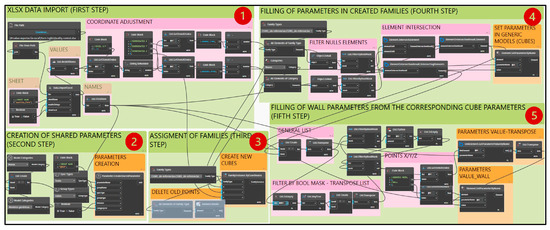
Figure 11.
Entire Dynamo routine, organized in five steps.
Step (1) begins with the import of the XLSX file generated in QGIS, which contains the completed inspection records. The file is read from the computer’s local storage, and the data are parsed into three separate lists: the names of the attributes, the geographic coordinates of the inspection points, and the corresponding attribute values. The coordinate values are then reformatted to align with the Revit coordinate system, ensuring consistency between GIS and BIM environments. In step (2), a set of shared parameters is created within the BIM model. These parameters are labeled according to the fields defined in the digital inspection form and will serve as the repository for the incoming data.
Step (3) involves generating and placing a generic Revit family configured as a cube at each inspection point. These cube instances are positioned using only the X and Y coordinates, while the Z coordinate is set to a fixed elevation. This simplification was necessary because the inspection form does not include height information, and the method is based on a two-dimensional plan view. As a result, the cube positions reflect the horizontal location of each inspected element, but not its vertical placement within the building. This may lead to overlaps in cases where elements share the same X and Y position at various heights (for example, beams and walls aligned vertically). To address the risk of data duplication, the routine includes a sub-process that automatically deletes any previously placed cubes before generating new ones. This ensures that every update reflects only the most recent inspection data. The spatial distribution of the cube instances across the floor plan is shown in Figure A8. In step (4), the attribute values are written into the shared parameters of each cube, effectively associating the inspection data with the corresponding spatial location. Intersections between the cubes and wall elements are then identified. Two mapping lists are generated based on these intersections: one for the cubes and one for the walls. Finally, in step (5), the inspection values stored in the cube instances are transferred to the corresponding wall elements through the intersection mapping. As a result, each wall included in the inspection process receives the attribute data collected in the field, stored as shared parameters within the BIM model. As each wall progresses through its respective inspection phases, the parameters stored in the BIM model are progressively updated. These records reflect the specific status of each control activity performed in the field. Figure 12 illustrates a Revit properties panel displaying the quality parameters assigned to a wall element after completing all control phases.
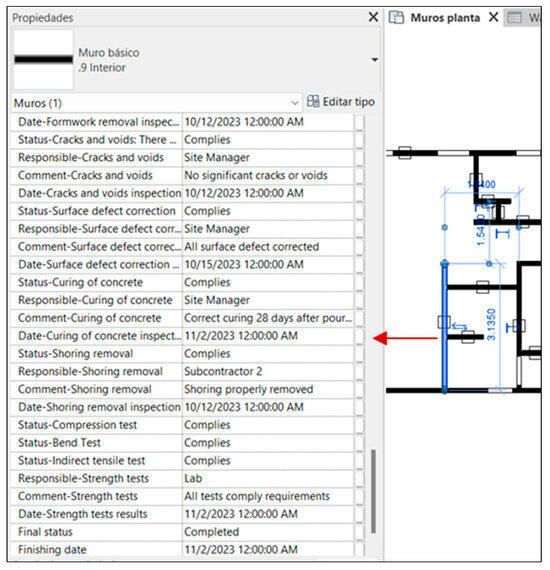
Figure 12.
Wall quality parameters on the Revit properties panel.
To support the monitoring and visualization of inspection progress, Revit’s built-in tools were used to generate a multi-category schedule and a visual control map. The schedule displays relevant metadata, including the last recorded compliance status, inspection coordinates, and dates for each structural wall. Figure 13a shows the resulting tabular view configured for this purpose. In parallel, a set of graphical filters was created to visually represent the inspection status within the BIM environment. In the case study, elements pending inspection were highlighted in red, while those marked as completed appeared in green. This approach allows project stakeholders to assess the quality control status of building elements directly in the model view, as shown in Figure 13b.
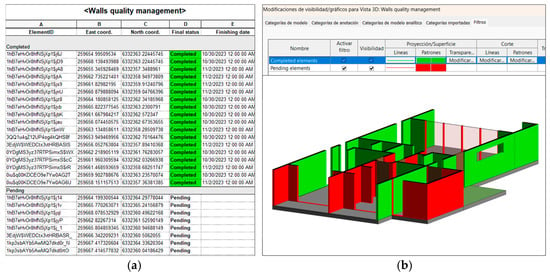
Figure 13.
Visualization of quality inspection results on Revit: (a) wall quantity table showing parameters imported from the inspection form; (b) visualization of wall status in the model.
6. Discussion
Quality assurance during the construction phase presents several challenges when establishing and implementing a QMS [83]. Among these challenges are the fragmentation of quality information among stakeholders, reliance on paper-based records, and the inefficiency of 2D drawings for on-site inspections [49]. Various solutions have been proposed to address these issues, including the use of programming tools to automate the entry of quality defect data into virtual BIM models [59]. Some approaches also incorporate APIs to build user-friendly environments for efficient data handling [62]. However, these solutions often lack alignment with international quality standards.
This study presents QualiSite, a digital tool that integrates widely adopted construction technologies to define a workflow aligned with the organizational and process-based requirements of ISO 9001:2015. Its implementation leverages BIM as a central platform for quality data management [81], offering a practical solution for organizations pursuing QMS certification and already using the tools adopted in this study [84]. Beyond the lack of previous studies aligning BIM and GIS with ISO 9001:2015, it is essential to compare this method with established quality frameworks, including Lean Construction, Six Sigma, and SPC. These methodologies promote continuous improvement, process control, and efficiency. However, they generally lack integration with real-time georeferenced data and depend on manual or siloed information management. The proposed method enhances these traditional approaches by incorporating spatial and visual data through a BIM-GIS workflow, improving traceability, responsiveness, and decision-making. This innovation aligns with the CPS paradigm, promoting automation and interoperability in construction quality management. Several recent studies have explored digital quality management using BIM or GIS independently. For instance, Holkar and Pataskar [6] employed BIM-based 4D modeling to address preconstruction quality issues, while Su et al. [85] proposed a GIS platform to optimize material layout in renovation projects. Despite their benefits, these approaches did not achieve full integration between spatial inspection data and BIM models. Our method advances this integration by enabling a bidirectional flow between GIS-based inspection records and BIM elements, in full compliance with ISO 9001:2015. Still, challenges remain. As noted by Song et al. [86], BIM-GIS integration often lacks vertical (Z-axis) detail, limiting its applicability to multi-level buildings. This limitation was observed in our case study, particularly in distinguishing overlapping components like beams or façades. Additional manual processes, such as file synchronization and georeferencing, also introduce operational complexity. Furthermore, interoperability with open formats such as IFC is currently limited, which restricts the tool’s broader applicability.
The digitization of inspection forms demonstrated the feasibility of adapting existing quality records into structured, cloud-based formats. These forms, configured with text, numeric, date, and coordinate fields, allow real-time multi-user access and facilitate customization for different inspection phases [87]. While QGIS enables detailed form configuration, the mobile application QField does not enforce consistency checks or data validation during field use. Future development could address this limitation by implementing automatic input validation. Examples include expected value ranges, format restrictions, or mandatory fields to ensure complete and accurate form submissions. Such enhancements would reduce errors and reinforce traceability in quality records.
Another significant limitation of the current implementation is its reliance on a two-dimensional (XY) coordinate system, which restricts the precise geolocation of inspection points in multi-story or vertically complex structures. When multiple quality control elements share the same XY coordinates but differ in elevation, overlaps in the plan view can create ambiguity and hinder the accurate assignment of inspection data to building components. Currently, inspectors must manually specify elevation, which increases the risk of data entry errors and spatial inconsistencies. To mitigate this limitation, several technological strategies may be considered. LiDAR scanning can produce high-resolution 3D point clouds with embedded XYZ data, enabling automated assignment of elevation values and improving vertical accuracy. This would reduce the need for manual input and minimize spatial ambiguities. Alternatively, photogrammetry using drones or handheld cameras can generate 3D meshes from site imagery. Although this method offers slightly lower accuracy than LiDAR, it is often more cost-effective and accessible for small to medium-sized projects. In addition, implementing 3D GIS platforms that support elevation-aware spatial layers would allow inspection points to be visualized and assigned at different heights within the same coordinate system, enhancing clarity in vertically stacked environments. Furthermore, manual file synchronization between GIS and BIM environments remains a challenge. Current workflows require exporting spreadsheets and executing data-import routines, which can introduce delays or mismatches. To improve this process, middleware tools or custom APIs could automate file transfer, validate incoming data, and maintain consistency between systems. These enhancements would reduce operational burden and support more reliable and scalable quality management operations. Limitations in real-time positioning due to weak satellite signals or limited connectivity may affect location accuracy on mobile devices. In such cases, the precise placement of inspection points still depends on the inspector’s interpretation of floor plans and physical site conditions, emphasizing the need for improved field positioning solutions.
BIM models have proven highly effective for storing and managing quality data [88,89]. Parameters linked to each model element facilitate tracking inspection status and nonconformities [90]. Revit’s Dynamo environment further supports automation by enabling parameter assignment based on inspection form data. However, visual overlaps in BIM elements (e.g., stacked cubes) may cause misassignments during the data integration. A key contribution of this study is the reintegration of field inspection data into the BIM model via Dynamo. The process closes the loop between site data collection and digital representation, transforming the BIM model into a centralized, traceable, and ISO-compliant repository for quality records. This contribution addresses a gap in prior studies, which often lacked such feedback mechanisms. In response to the research question, the case study demonstrates that integrating BIM and GIS, aligned with ISO 9001:2015, improves the traceability and effectiveness of quality management during construction. Digital forms and georeferenced inspections enabled structured monitoring and consistent documentation. At the same time, the integration into the BIM model supported visualization and follow-up of quality controls, facilitating informed decision-making among project stakeholders. While the perceived improvements in traceability and decision-making were inferred from integrating digital inspection data and their visualization in the BIM model, these claims have not yet been validated through formal stakeholder assessments. Future studies should include structured feedback from field inspectors, quality managers, and project coordinators to evaluate usability, perceived efficiency, and support for decision-making. Additionally, integrating time-motion analysis or audit trails could provide objective evidence of how the tool influences inspection workflows and corrective action processes.
The proposed workflow automates tasks typically performed manually, such as data storage, form generation, and model integration. However, it still requires manual operations like file synchronization and data export. Future implementations could optimize these steps to reduce friction and increase reliability. While the present implementation focuses on demonstrating the system’s functional validity, future research should include quantitative indicators, such as reductions in inspection time, error rates, or rework frequency, to provide stronger empirical evidence of its effectiveness. These metrics were not incorporated at this stage, as the primary objective was to establish a standards-aligned and replicable workflow that could serve as a foundation for future benchmarking in more complex scenarios. To advance this objective, future studies should consider incorporating specific performance metrics that capture the practical impact of the proposed workflow. These may include indicators such as average inspection duration per element, percentage of complete versus incomplete records, error frequency in form filling, or delays in data availability between on-site collection and model integration. Additionally, structured protocols—such as time-motion studies, stakeholder feedback forms, or comparison with baseline methods—could support empirical evaluations of efficiency and reliability. Establishing such benchmarks will be essential to demonstrate the system’s operational value and guide its refinement and broader adoption in more demanding construction contexts. In parallel with these future performance assessments, the initial validation was limited to a single-story residential project. This decision ensured full control over variables and a reliable implementation environment. It confirmed the feasibility and operability of the system. The modular structure of the workflow supports scaling to complex contexts, including infrastructure projects and multi-story buildings. Future adaptations could incorporate Z-coordinates, segmented control zones by level or activity, and advanced visualization platforms to manage increased spatial complexity. Although the current implementation was developed using proprietary tools such as Revit and Dynamo for BIM, and QGIS/QField for GIS-based inspection, the underlying structure of the workflow is adaptable to other software environments. These platforms were selected due to their maturity, accessibility, and support for parametric modeling and geospatial data. To broaden the applicability of the proposed method, future developments should explore its implementation using open standards and interoperable formats. For instance, adopting workflows based on IFC would facilitate compatibility with a broader range of BIM tools and support data exchange across heterogeneous systems. The same principle applies to the GIS component, where integration with other spatial data platforms could enable similar functionality. These adjustments would enhance the generalizability of the method, allowing it to be replicated in diverse technological contexts and organizational settings while maintaining alignment with ISO 9001:2015 requirements.
The originality of this work lies in integrating BIM and GIS with ISO 9001:2015, a combination not previously addressed in building quality literature. The method provides structured and traceable workflows that comply with international standards. From a research perspective, it opens new avenues for exploring how digital inspection systems can align with quality frameworks. For industry, it offers a replicable and adaptable solution to enhance inspection traceability and documentation. Future studies could validate the method in larger projects, explore the use of AI for anomaly detection, and expand interoperability with open data formats. Another promising direction is the integration of blockchain technology. Blockchain could improve inspection data reliability, transparency, and auditability by ensuring immutable records of events, approvals, and corrective actions. This would reinforce trust in digital quality systems and could be explored in future implementations.
Table 3 synthesizes the discussed implementation status and research outlook by providing a comparative overview of the current functionalities and the planned enhancements. This summary reinforces the system’s relevance and points to key areas for future development and scalability.

Table 3.
Overview of implemented and planned functionalities in the proposed quality management system.
The proposed enhancements can be prioritized based on feasibility and expected impact to provide a more precise roadmap for future development. In the short term, priority will be given to automating GIS-BIM data synchronization and supporting elevation data integration to address current workflow limitations. Medium-term efforts will focus on incorporating automated data validation, enabling user feedback mechanisms, extending compatibility to open formats such as IFC, and establishing performance metrics for quantitative evaluation. In the long term, the integration of advanced technologies such as artificial intelligence (AI)-based anomaly detection, blockchain for immutable records, and hierarchical model structures for complex vertical elements will be explored. This prioritization supports a progressive and scalable system evolution while aligning with ISO 9001:2015 and CPS principles. Overall, this roadmap aligns with the digital transformation goals in construction quality management and supports the integration of future innovations, such as AI-based analysis, 3D spatial processing, and open-format interoperability.
7. Conclusions
Quality management during the construction phase is critical in ensuring compliance with technical requirements and improving project performance. Developing robust quality management systems can provide significant benefits to construction organizations, including process standardization, enhanced traceability, and potential certification under international standards such as ISO 9001:2015. This study introduced QualiSite, a digital tool that supports these objectives by integrating BIM and GIS technologies into a unified quality management workflow.
The proposed approach employs QGIS and QField to design and operate georeferenced inspection forms. At the same time, Revit serves as the central platform for storing and managing quality information within a virtual model. The integration of inspection data into the BIM model is achieved through Dynamo, enabling partial automation of key tasks such as parameter generation, data insertion, and visual monitoring. The tool was validated in a small-scale case study focused on the construction of reinforced concrete walls, confirming its feasibility and operability. The results demonstrated consistent data flow between systems and improved traceability across inspection phases, supporting informed decision-making and enhanced documentation quality.
Future research should prioritize the integration of vertical coordinate data to support multi-level inspections, the automation of GIS-BIM synchronization, and the incorporation of performance metrics to evaluate system effectiveness. Compatibility with open formats such as IFC should be strengthened by mapping shared parameters to standardized schemas and using middleware or IFC-compatible platforms for structured data exchange. Furthermore, incorporating AI for anomaly detection and decision support and exploring blockchain-based solutions for immutable quality records would enhance system transparency, auditability, and operational efficiency. These developments would broaden the applicability of QualiSite across diverse project contexts and contribute to its scalability and long-term integration within digital construction ecosystems. Collaborative efforts between academia and industry could accelerate adoption, ensuring that tools like QualiSite evolve in alignment with real-world needs, technological advances, and regulatory frameworks.
Author Contributions
Conceptualization, E.A., F.L.-G. and J.A.L.-G.; methodology, P.M., E.A., P.A.-S. and J.A.L.-G.; software, P.M., P.A.-S. and F.L.-G.; validation, P.M., E.A., P.A.-S. and J.A.L.-G.; formal analysis, P.M. and P.A.-S.; investigation, P.M., E.A., P.A.-S. and J.A.L.-G.; resources, E.A., F.L.-G. and J.A.L.-G.; data curation, P.M., P.A.-S. and F.L.-G.; writing—original draft preparation, P.M., E.A. and P.A.-S.; writing—review and editing, P.M., E.A. and P.A.-S.; visualization, P.M. and P.A.-S.; supervision, E.A., P.A.-S. and J.A.L.-G.; project administration, E.A. and J.A.L.-G.; funding acquisition, J.A.L.-G. All authors have read and agreed to the published version of the manuscript.
Funding
This research was funded by the Spanish Ministry of Economy and Competitiveness, MICIN/AEI/10.13039/501100011033, through the project PID2021-126405OB-C32, co-financed by FEDER—A Way to Make Europe, and by Junta de Comunidades de Castilla-La Mancha through the project SBPLY/23/180225/000113.
Data Availability Statement
The original contributions presented in the study are included in the article; further inquiries can be directed to the corresponding authors.
Conflicts of Interest
The authors declare no conflicts of interest.
Appendix A
Appendix A.1. Quality Control Checklist

Table A1.
Quality control activities for wall construction, according to [82].
Table A1.
Quality control activities for wall construction, according to [82].
| Phase | Quality Controls |
|---|---|
| Prior to concrete pouring | Layout of walls according to blueprint dimensions. |
| Leveling and cleaning of the wall’s support base on the foundation. | |
| Placement of rebar, verifying diameters, lengths, and spacing based on structural design. | |
| Installation of formwork: free of holes, rigid, non-stick; includes scaffoldings for safe concrete pouring. | |
| Verify equipment availability for the execution of the phase. | |
| During concrete pouring | Concrete pouring with appropriate equipment, following technical specifications. |
| Compaction in layers, ensuring vibrator spacing and continuity. | |
| Recording weather conditions during inspection (rain, snow, wind). | |
| After concrete pouring | Curing of concrete using methods to preserve humidity and ensure strength development. |
| Timely removal of formwork and shoring. | |
| Surface inspection for cracks, voids, and other defects. | |
| Correction of surface defects with compatible materials, ensuring homogeneity. | |
| Performance of strength tests: compression, bending, and indirect shear in accordance with standards. |
Appendix A.2. Device Specifications

Table A2.
Technical specifications of the mobile device employed in the case study.
Table A2.
Technical specifications of the mobile device employed in the case study.
| Specification | Samsung® Galaxy Tab S6 Lite |
|---|---|
| Operating system | Android® |
| Dimensions | 244.5 × 154.3 × 7.0 mm |
| Screen size | 10.4″ (263.1 mm) |
| Connectivity | Wi-Fi 2.4 G + 5 GHz |
| Location technology | GPS, Glonass, Beidou, Galileo, QZSS |
Appendix A.3. Data Synchronization and Workflow Details
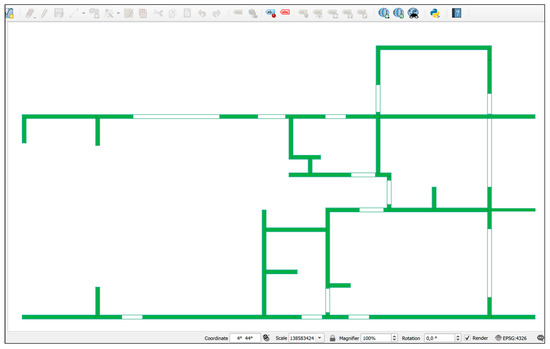
Figure A1.
QGIS interface containing the imported DXF drawing.
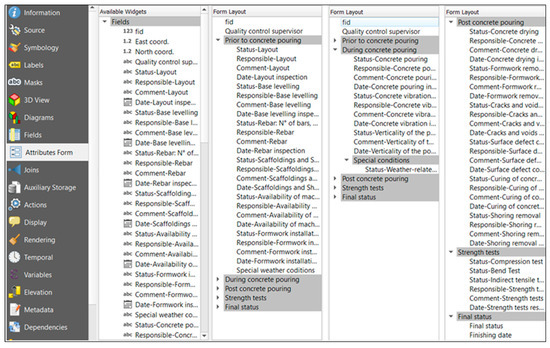
Figure A2.
Final aspect of the form and its sections.

Figure A3.
Configuration of text filling as a value map or a dropdown list.
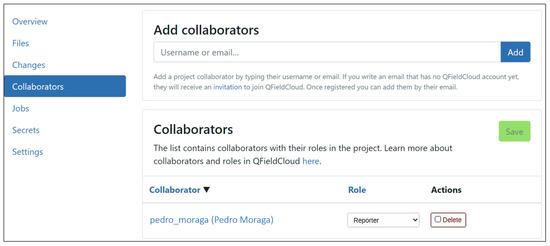
Figure A4.
QField Cloud interface on web platform: permissions settings and collaborators invited to the project.

Figure A5.
Changes updating on cloud storage.

Figure A6.
Synchronization of the quality inspection form between QFieldCloud and QGIS.

Figure A7.
Exporting inspection form to XLSX file: (a) layer name setting; (b) exported XLSX spreadsheet.
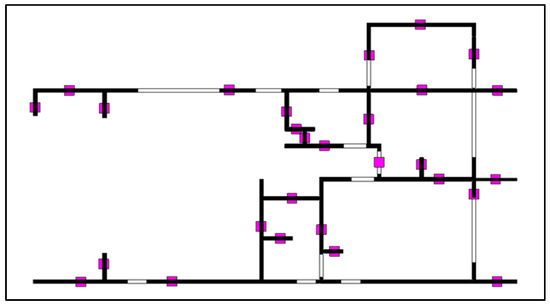
Figure A8.
Floor plans with generic models (cubes) added.
References
- Han, L.; Bian, X.; Gu, S.; Liu, C.; Pan, W.; Zhao, X. Research on Construction Quality Management Based on BIM. Int. J. Front. Eng. Technol. 2022, 4, 56–62. [Google Scholar] [CrossRef]
- Nguyen, P.T.; Nguyen, T.A.; Cao, T.M.; Vo, K.D.; Huynh, D.B.; Nguyen, Q.; Phuong, T.P.; Le, L.P. Construction Project Quality Management Using Building Information Modeling 360 Field. Int. J. Adv. Comput. Sci. Appl. 2018, 9, 228–233. [Google Scholar] [CrossRef]
- Liu, H.; Duan, Y. Production and Construction Quality Management System of Prefabricated Buildings Based on BIM Technology. Int. J. Ind. Syst. Eng. 2023, 43, 103–114. [Google Scholar] [CrossRef]
- Li, X.; Xie, W.; Yang, T.; Lin, C.; Jim, C.Y. Carbon Emission Evaluation of Prefabricated Concrete Composite Plates during the Building Materialization Stage. Build. Env. 2023, 232, 110045. [Google Scholar] [CrossRef]
- Khadim, N.; Thaheem, M.J.; Ullah, F.; Mahmood, M.N. Quantifying the Cost of Quality in Construction Projects: An Insight into the Base of the Iceberg. Qual. Quant. 2023, 57, 5403–5429. [Google Scholar] [CrossRef]
- Holkar, M.R.N.; Pataskar, M.S. Quality Management In Construction Industry By Using Building Information Modelling (BIM). J. Univ. Shanghai Sci. Technol. 2021, 23, 265–276. [Google Scholar] [CrossRef]
- Muhammad, K.M.A.; El Shimy, H.G.; Abd Elsalam, A.A.E.H. Evaluating the Quality of Construction Projects in Egypt and Identifying the Factors That Influence Deviation. HBRC J. 2024, 20, 43–54. [Google Scholar] [CrossRef]
- Silalahi, A.P.; Widjajakusuma, J.; Tanuhendrata, M.S.; Suraji, A. A Conceptual Framework for Integrating QSHE in Construction. In Proceedings of the IOP Conference Series: Earth and Environmental Science; Institute of Physics: London, UK, 2023; Volume 1195. [Google Scholar]
- Santelices, C.; Herrera, R.; Muñoz, F. Problems in Quality Management and Technical Inspection of Work: A Study Applied to the Chilean Context. Rev. Ing. Constr. 2019, 34, 242–251. [Google Scholar] [CrossRef]
- Muruganandham, R.; Venkatesh, K.; Devadasan, S.; Harish, V. TQM through the Integration of Blockchain with ISO 9001:2015 Standard Based Quality Management System. Total Qual. Manag. Bus. Excell. 2022, 34, 1–21. [Google Scholar] [CrossRef]
- Idrissi Gartoumi, K.; Aboussaleh, M.; Zaki, S. Implementing Lean Construction to Improve Quality and Megaproject Construction: A Case Study. J. Financ. Manag. Prop. Constr. 2024, 29, 1–22. [Google Scholar] [CrossRef]
- Sindhwani, R.; Vaidya, O.S.; Antony, J.; Shokri, A. Evaluating Performance of Projects Using Six Sigma Approach. IEEE Trans. Eng. Manag. 2023, 70, 3539–3552. [Google Scholar] [CrossRef]
- Bottani, E.; Montanari, R.; Volpi, A.; Tebaldi, L.; Maria, G. Di Statistical Process Control of Assembly Lines in a Manufacturing Plant: Process Capability Assessment. Procedia Comput. Sci. 2021, 180, 1024–1033. [Google Scholar] [CrossRef]
- Panyukov, D.; Kozlovskii, V.; Aidarov, D.; Shakurskii, M. Effectiveness of FMEA Risk Analysis. Russ. Eng. Res. 2022, 42, 1070–1072. [Google Scholar] [CrossRef]
- ISO 9001:2015; ISO Quality Management Systems-Requirements. International Organization for Standardization (ISO): Geneva, Switzerland, 2015.
- Zhuman, Y.; Juman, J.; Makulova, A.; Kalaganov, B.; Tagay, A.; Bastarova, U. Mechanism of introduction of quality management system at the enterprises of the construction industry: Case of the republic of kazakhstan. Bus. Manag. Econ. Eng. 2024, 22, 240–254. [Google Scholar] [CrossRef]
- Castillo-Peces, C.; Mercado-Idoeta, C.; Prado-Roman, M.; Castillo-Feito, C. The Influence of Motivations and Other Factors on the Results of Implementing ISO 9001 Standards. Eur. Res. Manag. Bus. Econ. 2018, 24, 33–41. [Google Scholar] [CrossRef]
- Sweis, R.J.; Jaradat, M. Project Management Performance of Construction Projects in Jordan: A Comparative Study of ISO 9001-Certified and Non-Certified Companies. TQM J. 2022, 34, 1341–1364. [Google Scholar] [CrossRef]
- Meng, Q. A Review of Integrated Applications of BIM and Related Technologies in Whole Building Life Cycle. Eng. Constr. Archit. Manag. 2020, 27, 1647–1677. [Google Scholar] [CrossRef]
- Jofré-Briceño, C.; Rivera, F.M.; Atencio, E.; Herrera, R.F. Implementation of Facility Management for Port Infrastructure through the Use of Uavs, Photogrammetry and Bim. Sensors 2021, 21, 6686. [Google Scholar] [CrossRef]
- Konstantinos Gkoumas Marcin Stepniak, I.C.; dos Santos, F.M. New Technologies for Bridge Inspection and Monitoring: A Perspective from European Union Research and Innovation Projects. Struct. Infrastruct. Eng. 2024, 20, 1120–1132. [Google Scholar] [CrossRef]
- Gang, J.; Feng, C.; Shu, W. A Framework for BIM-Based Quality Supervision Model in Project Management. In Proceedings of the Thirteenth International Conference on Management Science and Engineering Management; Springer International Publishing: Berlin/Heidelberg, Germany, 2020; Volume 1002. [Google Scholar]
- Fidel Lozano-Galant Angela Montalvo, E.A.R.P.; Lozano-Galant, J.A. An Open-Source GIS App for Digitalising Bridge Inspections and Automating BIM Model Integration. Struct. Infrastruct. Eng. 2025, 1–12. [Google Scholar] [CrossRef]
- Chen, X.; Chang-Richards, A.Y.; Pelosi, A.; Jia, Y.; Shen, X.; Siddiqui, M.K.; Yang, N. Implementation of Technologies in the Construction Industry: A Systematic Review. Eng. Constr. Archit. Manag. 2022, 29, 3181–3209. [Google Scholar] [CrossRef]
- Altıntaş, Y.D.; Ilal, M.E. Loose Coupling of GIS and BIM Data Models for Automated Compliance Checking against Zoning Codes. Autom. Constr. 2021, 128, 103743. [Google Scholar] [CrossRef]
- Zavari, M.; Shahhosseini, V.; Ardeshir, A.; Sebt, M.H. Multi-Objective Optimization of Dynamic Construction Site Layout Using BIM and GIS. J. Build. Eng. 2022, 52, 104518. [Google Scholar] [CrossRef]
- Cepa, J.J.; Pavón, R.M.; Alberti, M.G.; Caramés, P. TOWARDS BIM-GIS INTEGRATION FOR ROAD INTELLIGENT MANAGEMENT SYSTEM. J. Civ. Eng. Manag. 2023, 29, 621–638. [Google Scholar] [CrossRef]
- Han, C.; Tang, F.; Ma, T.; Gu, L.; Tong, Z. Construction Quality Evaluation of Asphalt Pavement Based on BIM and GIS. Autom. Constr. 2022, 141, 104398. [Google Scholar] [CrossRef]
- Kaya, U.; Özener, O.Ö. A Strategic Evaluation of BIM-Driven Information Management in the Context of ISO 19650-2 Standard. Eng. Constr. Archit. Manag. 2024. ahead-of-print. [Google Scholar] [CrossRef]
- Ruzarovsky, R.; Horak, T.; Zelník, R.; Skypala, R.; Csekei, M.; Šido, J.; Nemlaha, E.; Kopcek, M. Development and Validation of Digital Twin Behavioural Model for Virtual Commissioning of Cyber-Physical System. Appl. Sci. 2025, 15, 2859. [Google Scholar] [CrossRef]
- Ismaeil, E.M.H. Asset Information Model Management-Based GIS/BIM Integration in Facility Management Contract. Sustainability 2024, 16, 2495. [Google Scholar] [CrossRef]
- Peffers, K.; Tuunanen, T.; Gengler, C.E.; Rossi, M.; Hui, W.; Virtanen, V.; Bragge, J. Design Science Research Process: A Model for Producing and Presenting Information Systems Research. arXiv 2020, arXiv:2006.02763. [Google Scholar]
- Cheng, Y. Application of BIM on Documenting Construction Defects. Int. J. Eng. Technol. 2018, 9, 392–397. [Google Scholar] [CrossRef]
- Moradabadi, B.; Noorzai, E.; Abbasi, S. BIM-Based Optimization Approach to Reduce Life Cycle Costs by Focusing on the Integration of Construction and Operation Phases in Office-Commercial Buildings. J. Build. Eng. 2024, 98, 111126. [Google Scholar] [CrossRef]
- Cherkina, V.; Shushunova, N.; Zubkova, J. Application of BIM-Technologies in Tasks of Quality Management and Labour Safety. MATEC Web Conf. 2018, 251, 06004. [Google Scholar] [CrossRef]
- Pelden, S.; Banihashemi, S.; Mohandes, S.R.; Arashpour, M.; Kalantari, M. Enhancing Infrastructure Planning and Design through BIM-GIS Integration. Struct. Infrastruct. Eng. 2025, 1–20. [Google Scholar] [CrossRef]
- Apriani, S.; Mursitama, T.N.; Fawzi, A.; Bali, A.; Syamil, A.; Saroso, H. An Empirical Study on the Factors Affecting the Implementation of Quality Management Systems Among Indonesian Multinational Companies. J. Syst. Manag. Sci. 2023, 13, 430–442. [Google Scholar] [CrossRef]
- PMI. PMBOK® Guide, 7th ed.; Project Management Institute, Inc.: Newtown Square, PA, USA, 2021. [Google Scholar]
- Darsono, F.B.; Nurdin, A.; Koin, S.T.; Thomas, A.K.; Mulyono, T.; Setiyawan, A.; Huda, K.; Fitriyana, D.F.; Widodo, R.D. Rusiyanto Visual Inspection and Non-Destructive Test (NDT) on ASTM A36 Welded Joints Produced by GMAW. Int. J. Integr. Eng. 2024, 16, 114–125. [Google Scholar] [CrossRef]
- Sabelli, R.; Adams, A.; Landis, D. Application of AISC Specification Requirements for Second-Order Analysis and Stability Design. Eng. J. 2023, 60, 155–174. [Google Scholar] [CrossRef]
- Hadidi, L.; Assaf, S.; Aluwfi, K.; Akrawi, H. The Effect of ISO 9001 Implementation on the Customer Satisfaction of the Engineering Design Services. Int. J. Build. Pathol. Adapt. 2017, 35, 176–190. [Google Scholar] [CrossRef]
- Arfan Bakhtiar Aditya Nugraha, H.S.; Pujotomo, D. The Effect of Quality Management System (ISO 9001) on Operational Performance of Various Organizations in Indonesia. Cogent Bus. Manag. 2023, 10, 2203304. [Google Scholar] [CrossRef]
- Martins, A.C.P.; de Carvalho, J.M.F.; Alvarenga, M.C.S.; de Oliveira, D.S.; Júnior, K.M.L.C.; Ribeiro, J.C.L.; Santos, G.S.; Verly, R.C. Detecting, Monitoring and Modeling Damage within the Decision-Making Process in the Context of Managing Bridges: A Review. Struct. Infrastruct. Eng. 2024, 1–23. [Google Scholar] [CrossRef]
- Lozano, F.; Emadi, S.; Komarizadehasl, S.; González-Arteaga, J.; Xia, Y. Enhancing Performance Evaluation of Low-Cost Inclinometers for the Long-Term Monitoring of Buildings. J. Build. Eng. 2024, 87, 109148. [Google Scholar] [CrossRef]
- Mitsuyoshi Akiyama, D.M.F.; Xu, Z. Probabilistic Service Life Assessment of Corroded Concrete Structures: A State-of-the-Art Review. Struct. Infrastruct. Eng. 2025, 1–20. [Google Scholar] [CrossRef]
- Cheng, Y.M. Building Information Modeling for Quality Management. In Proceedings of the ICEIS 2018—Proceedings of the 20th International Conference on Enterprise Information Systems, Funchal, Portugal, 21–24 March 2018; Volume 2, pp. 351–358. [Google Scholar] [CrossRef]
- Allen, E.; Costello, S.B.; Henning, T.F.P.; Chamorro, A.; Echaveguren, T. Integration of Resilience and Risk to Natural Hazards into Transportation Asset Management of Road Networks: A Systematic Review. Struct. Infrastruct. Eng. 2023, 1–19. [Google Scholar] [CrossRef]
- Marinho, A.; Couto, J.; Teixeira, J. Relational Contracting and Its Combination with the BIM Methodology in Mitigating Asymmetric Information Problems in Construction Projects. J. Civ. Eng. Manag. 2021, 27, 217–229. [Google Scholar] [CrossRef]
- Lin, Y.C.; Chang, J.X.; Su, Y.C. Developing Construction Defect Management System Using BIM Technology in Quality Inspection. J. Civ. Eng. Manag. 2016, 22, 903–914. [Google Scholar] [CrossRef]
- Riaz, H.; Iqbal Ahmad Khan, K.; Ullah, F.; Bilal Tahir, M.; Alqurashi, M.; Alsulami, B.T. Key Factors for Implementation of Total Quality Management in Construction Sector: A System Dynamics Approach. Ain Shams Eng. J. 2023, 14, 101903. [Google Scholar] [CrossRef]
- Azhar, S. Building Information Modeling (BIM): Trends, Benefits, Risks, and Challenges for the AEC Industry. Leadersh. Manag. Eng. 2011, 11, 241–252. [Google Scholar] [CrossRef]
- Machado, R.L.; Vilela, C. Conceptual Framework for Integrating BIM and Augmented Reality in Construction Management. J. Civ. Eng. Manag. 2020, 26, 83–94. [Google Scholar] [CrossRef]
- Choi, J.; Lee, S.; Kim, I. Development of Quality Control Requirements for Improving the Quality of Architectural Design Based on Bim. Appl. Sci. 2020, 10, 7074. [Google Scholar] [CrossRef]
- Namhun, L.; Talat, S.; Wang, G. Building Information Modeling for Quality Management in Infrastructure Construction Projects. In Proceedings of the 15th International Conference on Computing in Civil and Building Engineering; Springer: Berlin/Heidelberg, Germany, 2014; pp. 955–1865. [Google Scholar]
- Ma, G.; Wu, M.; Wu, Z.; Yang, W. Single-Shot Multibox Detector- and Building Information Modeling-Based Quality Inspection Model for Construction Projects. J. Build. Eng. 2021, 38, 102216. [Google Scholar] [CrossRef]
- Zhang, T.; Doan, D.T.; Kang, J. Application of Building Information Modeling-Blockchain Integration in the Architecture, Engineering, and Construction / Facilities Management Industry: A Review. J. Build. Eng. 2023, 77, 107551. [Google Scholar] [CrossRef]
- Fang, Z.; Liu, Y.; Lu, Q.; Pitt, M.; Hanna, S.; Tian, Z. BIM-Integrated Portfolio-Based Strategic Asset Data Quality Management. Autom. Constr. 2022, 134, 104070. [Google Scholar] [CrossRef]
- Park, S.; Kim, I. BIM-Based Quality Control for Safety Issues in the Design and Construction Phases. Archnet-IJAR 2015, 9, 111–129. [Google Scholar] [CrossRef]
- Chen, L.; Luo, H. A BIM-Based Construction Quality Management Model and Its Applications. Autom. Constr. 2014, 46, 64–73. [Google Scholar] [CrossRef]
- Shin, H.J.; Cha, H.S. Proposing a Quality Inspection Process Model Using Advanced Technologies for the Transition to Smart Building Construction. Sustainability 2023, 15, 815. [Google Scholar] [CrossRef]
- Biel, S. Concept of Using the BIM Technology to Support the Defect Management Process. Arch. Civ. Eng. 2021, 67, 209–229. [Google Scholar] [CrossRef]
- Xu, Z.; Huang, T.; Li, B.; Li, H.; Li, Q. Developing an IFC-Based Database for Construction Quality Evaluation. Adv. Civ. Eng. 2018, 2018, 3946051. [Google Scholar] [CrossRef]
- Ding, L.; Li, K.; Zhou, Y.; Love, P.E.D. An IFC-Inspection Process Model for Infrastructure Projects: Enabling Real-Time Quality Monitoring and Control. Autom. Constr. 2017, 84, 96–110. [Google Scholar] [CrossRef]
- Kalyan, T.S.; Zadeh, P.A.; Staub-French, S.; Froese, T.M. Construction Quality Assessment Using 3D As-Built Models Generated with Project Tango. Procedia Eng. 2016, 145, 1416–1423. [Google Scholar] [CrossRef]
- Bellido-Montesinos, P.; Lozano-Galant, F.; Castilla, F.J.; Lozano-Galant, J.A. Experiences Learned from an International BIM Contest: Software Use and Information Workflow Analysis to Be Published in: Journal of Building Engineering. J. Build. Eng. 2019, 21, 149–157. [Google Scholar] [CrossRef]
- Atencio, E.; Komarizadehasl, S.; Lozano-Galant, J.A.; Aguilera, M. Using RPA for Performance Monitoring of Dynamic SHM Applications. Buildings 2022, 12, 1140. [Google Scholar] [CrossRef]
- Cann, S.; Mahamadu, A.-M.; Prabhakaran, A.; Dziekonski, K.; Joseph, R. An Approach for Semi-Automated Data Quality Assurance within BIM Models. Eng. Manag. Prod. Serv. 2022, 14, 114–125. [Google Scholar] [CrossRef]
- Pinto, R.; Torres, P.M.B.; Lohweg, V. Closing Editorial: Advances and Future Directions in Autonomous Systems for Cyber-Physical Systems and Smart Industry. Appl. Sci. 2024, 14, 10673. [Google Scholar] [CrossRef]
- Bansal, V.K. Potential Application Areas of GIS in Preconstruction Planning. J. Prof. Issues Eng. Educ. Pract. 2016, 142. [Google Scholar] [CrossRef]
- Hazar Dib, N.A.-V.; Issa, R.R.A. A GIS-Based Visual Information Model for Buildng Construction Project Management. Int. J. Constr. Manag. 2013, 13, 1–18. [Google Scholar] [CrossRef]
- Chowdary, M.H.; Karthik, N.; Raju, N. Applications of 4D GIS Model in Construction Management. Int. J. Innov. Technol. Explor. Eng. 2019, 8, 2597–2608. [Google Scholar] [CrossRef]
- Alnaser, A.A.; Maxi, M.; Elmousalami, H. AI-Powered Digital Twins and Internet of Things for Smart Cities and Sustainable Building Environment. Appl. Sci. 2024, 14, 12056. [Google Scholar] [CrossRef]
- ESRI. ArcGIS for Personal Use. Available online: https://www.esri.com/en-us/arcgis/products/arcgis-for-personal-use/overview (accessed on 23 May 2025).
- QGIS. Spatial without Compromise. Available online: https://qgis.org/ (accessed on 23 May 2025).
- GRASS. Development Team. Bringing Advanced Geospatial Technologies to the World. Available online: https://grass.osgeo.org/ (accessed on 23 May 2025).
- HEXAGON. Leverage Your Geospatial Data with GeoMedia for GIS and Mapping. Available online: https://hexagon.com/products/geomedia (accessed on 23 May 2025).
- GEOBIS. International MapInfo Profesional V16.0. Available online: https://www.geobis.com/mapinfo-gis-software/ (accessed on 23 May 2025).
- Blue Marble Geographics Global Mapper. Available online: https://www.bluemarblegeo.com/global-mapper/ (accessed on 23 May 2025).
- Collao, J.; Lozano-Galant, F.; Lozano-Galant, J.A.; Turmo, J. BIM Visual Programming Tools Applications in Infrastructure Projects: A State-of-the-Art Review. Appl. Sci. 2021, 11, 8343. [Google Scholar] [CrossRef]
- Atta, I.; Bakhoum, E.S.; Marzouk, M.M. Digitizing Material Passport for Sustainable Construction Projects Using BIM. J. Build. Eng. 2021, 43, 103233. [Google Scholar] [CrossRef]
- Lozano, F.; Jurado, J.C.; Lozano-Galant, J.A.; de la Fuente, A.; Turmo, J. Integration of BIM and Value Model for Sustainability Assessment for Application in Bridge Projects. Autom. Constr. 2023, 152, 104935. [Google Scholar] [CrossRef]
- Solminihac, H.; Thenoux, G. Procesos y Técnicas de Construcción, 5th ed.; Ediciones Universidad Católica de Chile: Santiago, Chile, 2011. [Google Scholar]
- Patel, C.S.; Pitroda, J.R. Quality Management System in Construction: A Review. Reliab. Theory Appl. 2021, 16, 121–131. [Google Scholar] [CrossRef]
- Lin, Y.-C. Use of BIM Approach to Enhance Construction Interface Management: A Case Study. J. Civ. Eng. Manag. 2015, 21, 201–217. [Google Scholar] [CrossRef]
- Su, X.; Andoh, A.R.; Cai, H.; Pan, J.; Kandil, A.; Said, H.M. GIS-Based Dynamic Construction Site Material Layout Evaluation for Building Renovation Projects. Autom. Constr. 2012, 27, 40–49. [Google Scholar] [CrossRef]
- Song, Y.; Wang, X.; Tan, Y.; Wu, P.; Sutrisna, M.; Cheng, J.C.P.; Hampson, K. Trends and Opportunities of BIM-GIS Integration in the Architecture, Engineering and Construction Industry: A Review from a Spatio-Temporal Statistical Perspective. ISPRS Int. J. Geoinf. 2017, 3976. [Google Scholar] [CrossRef]
- Halder, S.; Afsari, K.; Chiou, E.; Patrick, R.; Hamed, K.A. Construction Inspection & Monitoring with Quadruped Robots in Future Human-Robot Teaming: A Preliminary Study. J. Build. Eng. 2023, 65, 105814. [Google Scholar] [CrossRef]
- Chan, D.W.M.; Olawumi, T.O.; Ho, A.M.L. Perceived Benefits of and Barriers to Building Information Modelling (BIM) Implementation in Construction: The Case of Hong Kong. J. Build. Eng. 2019, 25, 100764. [Google Scholar] [CrossRef]
- Lidelöw, S.; Engström, S.; Samuelson, O. The Promise of BIM? Searching for Realized Benefits in the Nordic Architecture, Engineering, Construction, and Operation Industries. J. Build. Eng. 2023, 76, 107067. [Google Scholar] [CrossRef]
- Xiang, Y.; Mahamadu, A.-M.; Florez-Perez, L. Engineering Information Format Utilisation across Building Design Stages: An Exploration of BIM Applicability in China. J. Build. Eng. 2024, 95, 110030. [Google Scholar] [CrossRef]
Disclaimer/Publisher’s Note: The statements, opinions and data contained in all publications are solely those of the individual author(s) and contributor(s) and not of MDPI and/or the editor(s). MDPI and/or the editor(s) disclaim responsibility for any injury to people or property resulting from any ideas, methods, instructions or products referred to in the content. |
© 2025 by the authors. Licensee MDPI, Basel, Switzerland. This article is an open access article distributed under the terms and conditions of the Creative Commons Attribution (CC BY) license (https://creativecommons.org/licenses/by/4.0/).